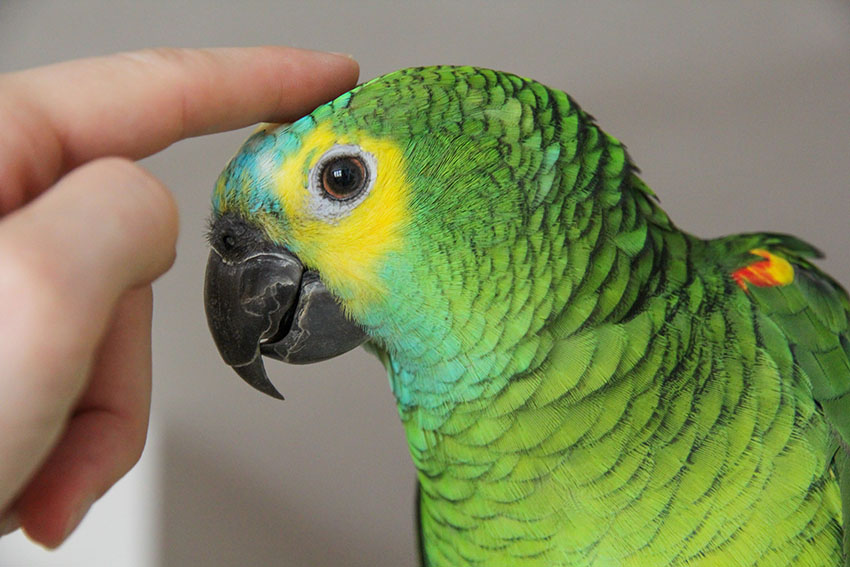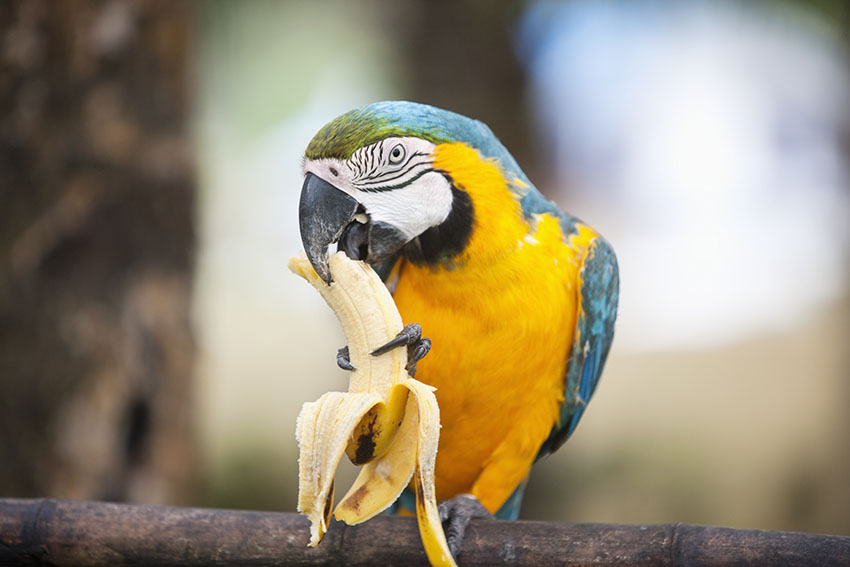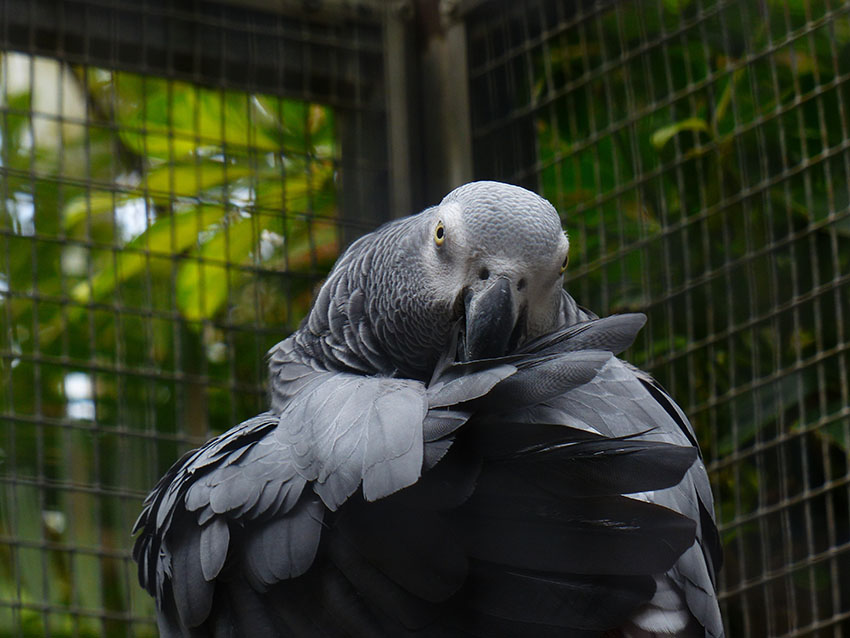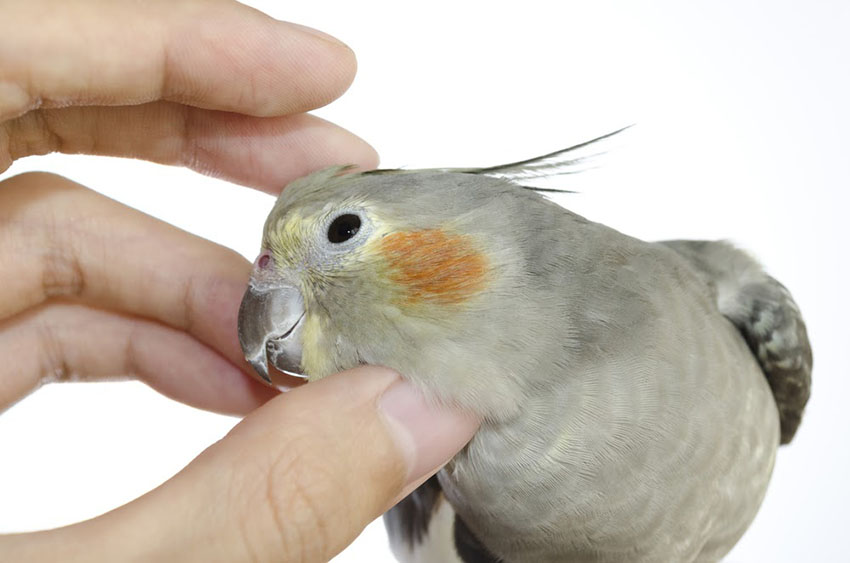In spite of their popular image as masters of wit, repartee and pieces-of-eight, not all parrots learn to talk. They are always vocal, but you need to put in time and effort to transform some of that chatter into recognisable human ‘speech’. Catching them young is the trick, but even then they need to be bombarded with human sounds on a daily basis. Even that isn’t a guarantee – a noisy household will sometimes inspire a parrot to make his own version of busy background noise, which isn’t always pleasing on the ear! If your household noise is less about screaming kids and more about single voices talking calmly, you’re in with a very good chance of a talking bird.

Blue-fronted Amazon - tame and ready to talk
The point to underline here is that some species are more apt to talk than others. The natural mimics of the family will be more inclined to latch onto human speech. Larger species in this category include the African Greys, some of the Amazons (notably the Double Yellow-headed and the Yellow-naped), Eclectus Parrots and Indian Ring-necked Parakeets. If you want a talking Macaw, the Blue-and-gold is a good bet, and of the Cockatoos, the Bare-eyed and Rose-breasted appear to have the most to say.
Of the smaller parrots, male Budgies and Lories are the best of the chatterboxes (for the former, see our separate Omlet Budgerigar Guide for more information). Cockatiels need catching young, although they don’t usually master many words. Most other species can be taught too, although the voice of many is indistinct.
Parrots are naturally noisy and sociable, so you can start to teach them words straight away, matter how hand-tamed they are.
First Lessons for Talking Parrots
In the early stages of teaching you’ll be repeating chosen phrases such as “Nero is a good boy!” Words spoken with feeling and dramatic expression make the biggest impression. Imagine you’re speaking encouragingly to a baby - that’s the sort of tone that gets results. Repeating the phrases ‘parrot fashion’ will deliver results eventually.

Blue-and-Golds are one of the most talkative of the Macaws
Once the bird gets the hang of human words he’ll be listening to everything you say. This is where some owners get into trouble, as their favourite curses and expletives can be adopted by the parrot, who will then employ them with an uncanny skill for perfect timing!/p>
Parrots make a wide variety of sounds to accompany their busy lives. These are largely social – greetings, disagreements, calls for attention, shouts of anger, etc – and when teaching a bird to talk, it helps if the sound is accompanied by interaction.
Tips for Teaching Parrots to Talk

African Greys are the most celebrated talkers amongst parrots
You should be able to loosen the bird’s tongue if you try some of the following:
- A good starting point is to talk as you put food or water into a cage. Start with a ‘Hello’-type greeting as you approach the cage or enclosure. Always say ‘goodbye’ (or similar) when you walk away from the bird or leave the room.
- Repeat these stock phrases whenever you’re near the parrot. Parrots are very interested in sounds, and will listen and watch you as you speak.
- Try to catch the parrot when he’s at his most receptive – first thing in the morning, or just before feeding time, for example – rather than when he’s distracted (i.e. tired, angry, busy with other birds, or in any way flustered).
- Choose some simple words or phrases, and repeat them for at least two minutes, and no longer than five. Do this as many times as possible during the day.
- Try to fit in several short teaching sessions over the course of each day.
- If you say things like “I love food!” as you fill the trays, your parrot will link the sound to the action. If you’re lucky, he will start to say “I love food!” when you begin the bowl-replenishing process. Make the chosen sounds every time you carry out a certain action. It will take time – months – but, at the very least, it will build your bond with the parrot.
- Naming vegetables and fruit is a good trick too. Hold out a piece of carrot, banana, or whatever, and say the word for it clearly. Over time, if he’s conducive to such training, the parrot will learn the word for each item of food. When you say ‘carrot’, he will know what you mean; and if he says the word, try to offer the food as a reward (without overdoing any single foodstuff – a clever parrot will soon learn that saying the magic word produces his favourite treat!)
- Words said with feeling tend to stick. Unfortunately, this is why swear words and things like “Wow!” “Stop it!” and “Ouch!” tend to creep into a parrot’s vocabulary. This should not be taken as a cue to shout at your bird, but it is worth bearing in mind (as a note of caution as much as anything!)
- Encourage the phrases you want by rewarding with treats and enthusiasm; and discourage undesirables by not responding, or by firing back a desirable word each time.
Tips for Reluctant Talkers
- There are alternatives to the ‘association’ type of learning. Choose a quiet moment with your bird – settling him on a standalone perch is ideal – and repeat your chosen phrase. Reward the parrot when he makes a noise in response.
- Parrots seem to pay intention to higher-pitched words and phrases. Female voices are therefore ideal vehicles for teaching speech to a bird.
- If your parrot still struggles to make sense of the noise, pick a single syllable word (such as “hi”), or the first syllable of a longer word. For example, if your parrot is called Nero, start with “Neer”, and only add the “o” when he’s mastered the first bit.
- If the parrot is hand-trained, hold him to your face as you speak, and let him see and hear the words close up.

Cockatiels are not the greatest talkers, but can often pick up a few words and phrases
- Involve another human in the process. When you say “Hello!”, your companion should respond with “Hello!” This gives the parrot more clues as to the required response. Most talking parrots seize on this eagerly, and are soon saying hello to everyone who walks into the room.
- Reward any progress with treats; but don’t offer the treat if the parrot has not spoken.
- If the problem is one of unfamiliarity with human voices (e.g. if the parrot is in a room with other birds but no constant human company), try using a radio, TV or music player to boost his familiarity with the noises people make.
Comments
Caroline, 8 April 2021
Hi ... I got my 5 yr old Female Orange Winged Amazon Parrot from my daughters father in law... He also has other birds budgie , cocktails cockatoos and some others. They all live outside ... with an aviary that they can go out daily too. They never really had any real socialising expect feeding nd cleaning etc. I understand that it will take time and patience for my Amazon to trust me fully ... which she does to a certain extent... I have had her for nearly 3months now ... which I have got her taking food from my hand , if I go to front of her cage she will come to the front to see me , she shakes her wings wen she hears my voice , she also squawks loudly at me in the morning lol, she will do the target clicking for a treat , but I have tried to get her to step up and she has tried to step on my finger but she doesn’t like the feel of my skin . Have tried with gloves on , she doesn’t like them either. Is there anything else I could do . Caroline
Alexis, 5 April 2019
My parrot is new to my home and when ever I try to touch him he growls and bites me. What should I do?
Krisi, 28 March 2019
What about singing a song? Would this help?